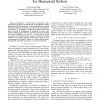Free Online Productivity Tools
i2Speak
i2Symbol
i2OCR
iTex2Img
iWeb2Print
iWeb2Shot
i2Type
iPdf2Split
iPdf2Merge
i2Bopomofo
i2Arabic
i2Style
i2Image
i2PDF
iLatex2Rtf
Sci2ools
IROS
2006
IEEE
2006
IEEE
Toward Interactive Reaching in Static Environments for Humanoid Robots
— Reaching is a critical task for humanoid robots, requiring the application of state-of-the-art algorithms for motion planning and inverse kinematics. Practical algorithms for solving these subproblems are currently not complete, offering resolution completeness or probabilistic completeness instead. While this lesser provision of completeness is acceptable in many cases, naively combining state-of-the-art approaches in motion planning and inverse kinematics can lead to a method that provides no measure of completeness. We present a resolution complete solution to the reaching problem for humanoid robots in static environments, and evaluate it against two other methods using a kinematically simulated humanoid in a virtual environment.
| Added | 12 Jun 2010 |
| Updated | 12 Jun 2010 |
| Type | Conference |
| Year | 2006 |
| Where | IROS |
| Authors | Evan Drumwright, Victor Ng-Thow-Hing |
Comments (0)

